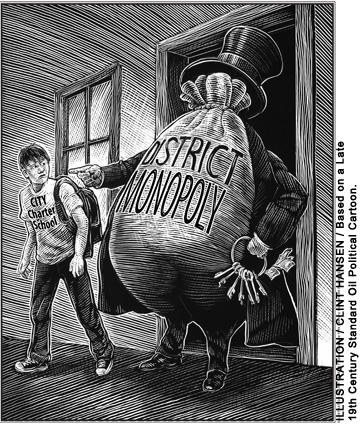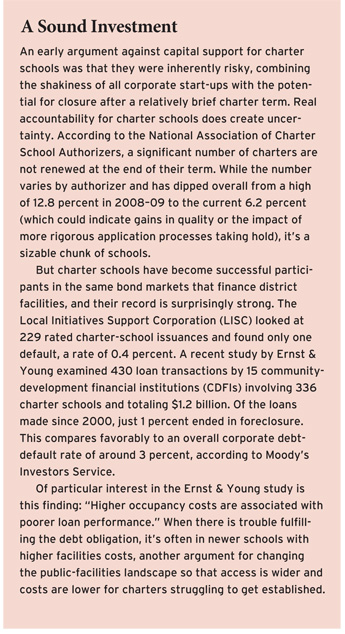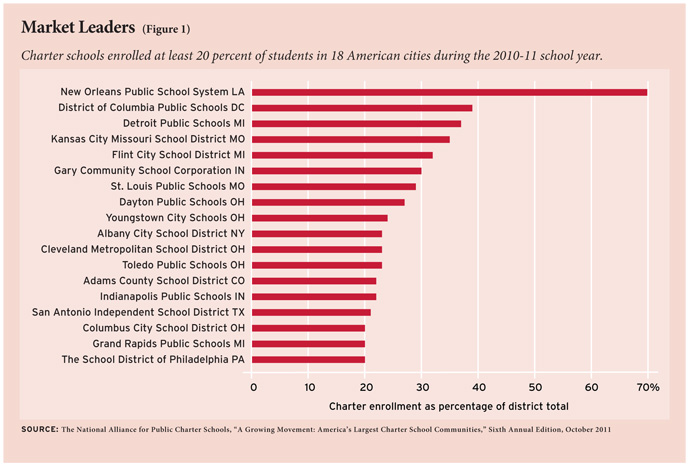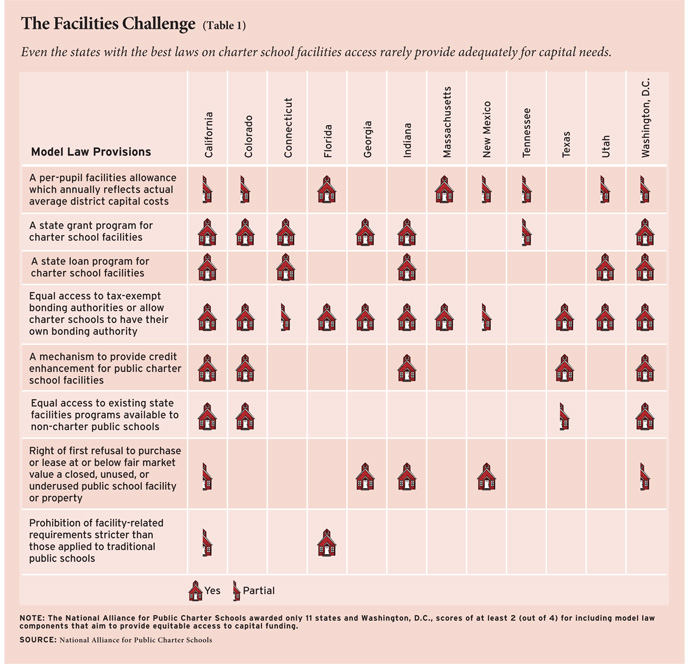 With our strong distaste for monopolies, America has developed a proud tradition of trust-busting. From Standard Oil to AT&T, Congress and the courts have intervened to keep corporate monopolists from controlling the terms of trade for their rivals. Yet in public K–12 education, there is a curious twist on this pattern: school districts have largely lost their monopoly on education programming, but are still the only game in town when it comes to financing, developing, and deploying public school buildings. The trust is only half-busted in this case—our laws lag decades behind the reality on the ground.
With our strong distaste for monopolies, America has developed a proud tradition of trust-busting. From Standard Oil to AT&T, Congress and the courts have intervened to keep corporate monopolists from controlling the terms of trade for their rivals. Yet in public K–12 education, there is a curious twist on this pattern: school districts have largely lost their monopoly on education programming, but are still the only game in town when it comes to financing, developing, and deploying public school buildings. The trust is only half-busted in this case—our laws lag decades behind the reality on the ground.
School districts held an exclusive franchise on public education services until 1991, when Minnesota passed the first law permitting public charter schools. Charter schools are publicly funded, authorized by various agencies designated in public law, but independently managed. They operate outside district control, and most can draw students from all across town, not just those who live within neighborhood boundaries. Virtual charter schools can attract students from all around the state, without regard to any traditional school-district boundary. Parents have a choice, competition has arrived, and innovation can flourish.
But there’s a catch: traditional public-school districts still own the great majority of school buildings, and with rare exceptions, public charter schools have no legal claim to them. If charters want to build their own facilities, they face enormous obstacles. They have no taxing power, no access to state capital budgets, and, ordinarily, no bonding authority—they are shut off from the prevailing public sources of revenue for school construction. Distressingly often, they are denied access even to school buildings that the district no longer uses. Charter schools must take a wide detour around this enormous fiscal pothole. They have won credit enhancements to sweeten private lending and federal incentives to encourage states to create charter-specific facilities programs, and they must conduct ongoing campaigns to raise funds from private donors.
The lack of available facilities is a direct and pressing constraint on the growth of high-quality charter schools. According to a recent survey by the National Charter School Research Project, scarcity of facilities was listed first among all reported external barriers to growth of charter management organizations, mentioned in 89 percent of responses.
Let’s explore the sources and consequences of the iron grip school districts typically enjoy over the financing, development, ownership, and deployment of public school facilities—and some promising strategies for breaking it.
Financing Challenges
 From the Minnesota statute on, access to dedicated revenues for facility construction was the gravest omission from state charter-school laws. The gap may have seemed reasonable at first. Charters were new and untried, and most were chartered for a term of five years, sometimes less. So even friendly policymakers resisted giving them the keys to funding instruments traditionally used by districts to build and maintain impressive, permanent structures. For a few years, as charters sprung up in storefronts and church basements, the policy almost seemed plausible (see sidebar).
From the Minnesota statute on, access to dedicated revenues for facility construction was the gravest omission from state charter-school laws. The gap may have seemed reasonable at first. Charters were new and untried, and most were chartered for a term of five years, sometimes less. So even friendly policymakers resisted giving them the keys to funding instruments traditionally used by districts to build and maintain impressive, permanent structures. For a few years, as charters sprung up in storefronts and church basements, the policy almost seemed plausible (see sidebar).
Today, a mere nuisance has burgeoned into the foremost hurdle to the rapid expansion of high-quality charter schools. As the number of students entering charters has grown steadily year by year, comprising in 2012 approximately 4.2 percent of public school students nationwide, the case for rethinking the capital requirements of the charter sector has become overwhelming. Today’s charter community boasts large schools, extensive networks, and impressive market share. In six major school districts (New Orleans, Louisiana; the District of Columbia; Detroit, Michigan; Kansas City, Missouri; Flint, Michigan; and Gary, Indiana), at least 30 percent of public school students are enrolled in public charter schools. Another 18 school districts enroll more than 20 percent of public school students in charter schools (see Figure 1). Charter school students represent at least 10 percent of overall enrollment in nearly 100 school districts.
Yet among the 41 states (and the District of Columbia) with charter laws, only 17 provide some kind of direct facilities aid, either capital grants or per-pupil funding, and just three of those provide annual per-pupil capital funding of more than $1,000. And while states deliver straightforward capital support to traditional school districts, their support for charter facilities is often halfhearted and ineffective. Thirty-four states have conduit bond-issuing agencies, but only a few have made the state’s credit (either general obligation or moral obligation) available to charters. Only Colorado has done so at scale (see Table 1).
School Districts Drive the Facilities Bus
The denial of facilities funding would be less problematic if charter schools had routine access to existing buildings that had been built for public school use and already paid for with tax dollars. But the laws governing school facilities were written a century or more before charters existed, when there was only one kind of “public school” in this country. Under such legacy laws, traditional districts remain the sole proprietor, able to make fairly arbitrary decisions about who else might benefit from these public goods. The disparity in legal status between district-managed public schools and chartered public schools is more acute than that of landlord and tenant; it’s more akin to that of landowner and sharecropper, since the charters have no statutory or contractual right to the property.
Documented examples of misalignment between student needs and building availability are legion. Consider only a few of the most celebrated cases on record:
• In late 2010, the Journal Sentinel reported that Milwaukee Public Schools spent more than $1 million a year to maintain 27 surplus school buildings. Yet the district refused sales to charter schools—on the grounds that they would compete with the district for students. In May 2011, the state legislature finally approved a measure allowing the City of Milwaukee to sell the buildings, despite the district’s objections.
• In December 2007, the Special Administrative Board of the St. Louis Public Schools approved terms on the sale of the old Hodgen Elementary School building that included a 100-year deed restriction prohibiting leasing of the building to medical clinics, taverns, adult entertainment facilities, and…charter schools. The restriction was removed by the board in 2009 after the measure was held up to well-deserved ridicule.
• In rural Pennsylvania, the Penns Valley Area School Board is leasing property for construction of a privately funded, $5 million community center that will house a YMCA, the county office for the aging, and other agencies. However, included in the 30-year lease is the following clause: “No groups in direct competition with the District are authorized to use the facility. Those groups in competition are defined as entities that serve the same purpose of the District at the same age level, i.e., charter schools.”
Even when there is plain statutory language giving charter schools a share of district building stock, it is too often interpreted away or just ignored.
In Ohio, state law gives charter schools first dibs on shuttered school buildings. But when a prime Columbus property went up for charter school bids in 2010, the district’s general counsel averred that “the district is under no obligation to accept any of the bids…If it rejects all bids, the district can enter into a contract sale at a negotiated price with any buyer.”
When the District of Columbia School Reform Act was passed by Congress in 1996, it included language providing that charter schools should have access to surplus public-school buildings. A succession of D.C. superintendents and mayors (as well as the Financial Control Board that oversaw city government in the late 1990s) ignored or circumvented the law’s intent. The D.C. Council subsequently strengthened the guarantee, providing charters the right of first offer on sales and leases. But there remains a lack of transparency, and much of the surplus inventory is not made available to charter schools. As charter financing expert Maria Sazon succinctly states, “On paper, the Washington, D.C., statutory provision regarding surplus buildings is one of the strongest in the country. In practice, however, the Washington, D.C., government too often ignores it.”
California is the only state that requires, as a matter of law, provision of adequate school facilities for every charter school authorized. It became the law in California in 2000 when voters passed Proposition 39, which requires that the Golden State’s public-school facilities “be shared fairly among all public school pupils, including those in charter schools.”
Initially, charter school advocates were exuberant at voter support for the new law. But they soon discovered that district compliance could hardly be taken for granted. The result has been the longest running school building soap opera in the nation. The California Charter Schools Association (CCSA) had to take both the San Diego and Los Angeles school districts to court to enforce compliance. In July 2005, the California Court of Appeals affirmed that districts must consider the needs of charter students and district students equally. But L.A. Unified’s continued recalcitrance resulted in another CCSA lawsuit in 2010, this time contesting the district’s failures to comply with both Proposition 39 and a 2008 settlement agreement setting out conditions for the charter-district relationship. The association contended that in 2010, for example, the district issued just 45 final offers in response to 81 charter school requests for space. None of the offers were in compliance with the law, and fewer than half were accepted by the charter schools. Those numbers did improve in 2011, with 43 schools accepting offers. In response, CCSA agreed to stay its lawsuit in June 2011.
Positive Signs
Not every school district is hostile to charters, however. Those reporting to mayors may have added incentive to create more expansive facilities policies. Under Mayor Michael Bloomberg, for example, nearly three-quarters of New York City’s charter schools are located in district facilities. Some enlightened district superintendents, such as Denver’s Tom Boasberg, simply view charters and district schools as threads in the same net of support for their city’s children. Boasberg welcomed charter schools into district facilities and by 2011, “16 charter schools operated in district facilities, representing approximately 48 percent of charter schools operating in the district, with 11 of these schools operating in a shared campus partnership.” As more schools began to locate in district facilities, Boasberg requested that some of them prioritize enrollment for students living in the neighborhood. Three of the 16 charters located in Denver Public School facilities now share a boundary with adjacent DPS schools.
Cleveland has embraced the nascent Breakthrough Schools coalition, which united several high-performing charters within a common organizational structure. The district authorizes the schools, has agreed to help them expand, and recently sold them four vacant school buildings. The district’s chief operating officer, Patrick Zohn, clearly saw an opportunity for the district in the $1.5 million transaction: “There’s not really a robust aftermarket for pre-owned school buildings,” Zohn said. “Come on down. We’re dealing, dealing, dealing.”
The Bill & Melinda Gates Foundation has brokered “compacts” between districts and charter schools in 14 cities. Each city’s agreement lists a series of steps the parties will take to ensure equity in resources, enrollment, and services; districts can apply for grants to fund implementation. Several of the compacts address facilities directly, and buildings will be provided at no or low cost for at least some charter schools in Denver; Hartford, Connecticut; Los Angeles; New Orleans; and other sites. The Nashville agreement, for example, promises to “include charter schools in the long-term strategic plans of the district including, but not limited to, student assignment planning and facility usage.”
State leadership can also change long-established attitudes and practices with respect to managing the facilities portfolio. In 2008, Louisiana used its massive post-Katrina settlement from the Federal Emergency Management Agency (FEMA) as core funding for a $1.8 billion renovation program for public school facilities in New Orleans—and did so in a revolutionary way. In announcing the program, then state superintendent of education Paul Pastorek said, “The proposal considers all public schools in New Orleans, without regard to governance…. We’re not building schools for the OPSB [Orleans Parish School Board], we’re not building schools for the RSD [the state-run Recovery School District], nor are we building schools for charters. We are building schools for the city of New Orleans.”
Farther north, Indiana governor Mitch Daniels got it exactly right when asked whether Indianapolis Public Schools should sell 13 closed buildings to charter schools. “Sell them? They should give them away!” he said, noting that charter schools are public schools and taxpayers have already paid for the buildings. In May 2011, Daniels signed into law legislation that among other provisions, allows charters to lease or purchase for $1 any unused, closed, or unoccupied school building that is maintained by a school corporation.
Whatever the original ownership or cost, surplus properties should rightly be considered a good held in trust for the future student population of the entire city. This calls for two kinds of actions:
• State legislatures should transfer to municipal leaders authority to manage the disposition of any school space already declared “surplus” by a school district, giving right of first refusal to public charter schools for sale or lease at no cost.
• In cities with no officially declared surplus but pressing demand for charter school expansion, state governments should commission third-party building audits to determine whether there is excess space. If there is sufficient space to provide for non-district-managed schools, authority over that surplus should also transfer to the municipal authority.
State legislatures should put the full faith and credit of the state behind all kinds of public schools, as Colorado has done. Governors and state superintendents should use their own funding leverage in the way Louisiana is doing, sponsoring school projects that serve the entire public-school portfolio and deciding further down the road which kind of schools will occupy which facilities.
A few jurisdictions have modified the customary five-year charter term to make charter schools more attractive to lenders: Arizona and Washington, D.C., both have 15-year charter terms, with high-stakes reviews happening at least every five years, and Colorado charters can be granted 30-year terms. Other states are awarding 10-year charters after the first term, or experimenting with virtually automatic renewal for charters consistently meeting a high performance bar. All of these strategies make charter schools more appealing to lenders by aligning their legal life spans more closely with that of mortgages and bonds. Longer charter terms can bring wary investors to the table, provided that there is also a strong oversight and accountability system in place.
Three Management Models
With clear policy guidance from the state, and with local municipal authorities taking responsibility for implementation, there are many ways to manage the public school–facilities portfolio. Following are three possibilities, each a variation on some established or already-tried approach.
The Real Estate Trust. As with many notions that challenge the educational status quo, this one can be traced to Paul Hill, the protean researcher at the University of Washington’s Center on Reinventing Public Education (CRPE). He consulted for the Education Commission of the States (ECS) in its 1999 report, Governing America’s Schools: Changing the Rules, which described a “public schools real estate trust” as follows: “In any locality, one or more real-estate trusts assume ownership of a community’s public school buildings, sell the surplus buildings, and build or lease additional facilities in areas with insufficient space. Such trusts help schools find space, as well as tenants for space they no longer need.” Facilities funding would flow directly to schools, which would then use it to lease from the trust.
NewSchools Venture Fund endorsed the idea of nonprofit trusts, at least within the charter sector, in a 2006 paper: “By aggregating capital from multiple sources and consolidating expertise within the organization—rather than in the principal’s office or the central office of a charter management organization—the trust would lower the financial and human cost of real estate development and enable greater access to facilities funding.”
The idea has gotten one rather bumpy road test. Portland, Oregon, created a trust as one outcome of its 2002 long-range facilities plan, initially charging it with disposition or redevelopment of its surplus properties. According to the Portland school board, the real estate trust was “a nonprofit, independent entity created by [Portland Public Schools], which could, at the board’s discretion, be given title to property deemed ‘surplus’ to either market or redevelop it on behalf of the school district.” However, the City of Portland never insisted that the trust act as an independent municipal agency with real powers over property. The trust devolved into an advisory body, and the school board finally amended its policies in early 2009 to formalize the trust’s reduced status.
Retrofitting the Construction Authority. A second approach relies on existing or modified municipal authorities, with an eye toward New York City’s experience. Its School Construction Authority is the rare local entity that has soup-to-nuts responsibility for financing, building, and overseeing public schools, largely because it is now controlled directly by the mayor.
What if cities (rather than school districts) were to create corporations, authorize them to do financing, and assign them the task of managing the public-school facilities portfolio so that both district and charter schools could be housed? These would be local bodies with local accountability.
Or cities could simply expand the portfolio of existing municipal building authorities to include schools. It’s truly curious that such authorities exist in many jurisdictions, financing and putting up municipal and county hospitals and other complexes, while the school district operates in a totally separate bubble. Wouldn’t it be far more efficient to consolidate that work?
Expanding Charter-based Models. Using a third strategy, municipalities would contract with nonprofits to take over and manage the entire school-facilities process.
The District of Columbia tiptoed up to the edge of this idea in 2005, when then superintendent Clifford Janey called for public-private partnerships to support improved school performance. One resulting project was EdBuild, sponsored by the Federal City Council (a business-based civic group). With a mission of “high-performing public schools, inside and out,” EdBuild sought to provide both facilities renovations and academic support to a group of low-performing schools in the District of Columbia, with a vision of eventually taking on a large swath of D.C. schools and creating space that could be used flexibly by both traditional district and charter schools. The venture went under after critics raised questions about the political connections of its sponsors, and the D.C. Council refused to fund its contract with the school system.
A number of strong nonprofits currently serve the national charter community, including New York–based Civic Builders, Los Angeles–based Pacific Charter School Development, and the DC-based Charter School Development Corporation. These organizations differ from traditional district construction agencies by combining financing with a broader development role, serving, in effect, as both the “facilities office” and the chief financial officer in getting projects done.
These and other nonprofits could surely serve a wider public, although there could be some trade-off between their entrepreneurial culture and the demands of fully public administration. Perhaps the charter bargain could be struck in facilities as well as operations: strong accountability for outcomes, with public reporting to a mayor or city council, but far more latitude in matters of budgeting and labor.
Start Now
The school district monopoly over public education facilities is an accident of history. The policy and practice of public education facilities would look far different today if there had been more than one choice of provider when the laws were being written. There may be 100 ways of accomplishing the transformation away from monopoly, but the best path will involve policy and finance reform at the state level; municipal rather than district oversight; and a combination of entrepreneurial energy with appropriate public accountability.
While the exact way forward may vary from one district to another, there should be no further delay in creating state laws and regulations that level the playing field between charters and other public schools. Even with existing rules of ownership, there is no excuse for bolting the doors to unused school buildings. There is no excuse for ignoring the fact that charter schools must take dollars out of classrooms to pay the rent.
Nelson Smith is a consultant on education policy and former president and CEO of the National Alliance for Public Charter Schools.
This article appeared in the Fall 2012 issue of Education Next. Suggested citation format:
Smith, N. (2012). Whose School Buildings Are They, Anyway? Making public school facilities available to charters. Education Next, 12(4), 50-57.




